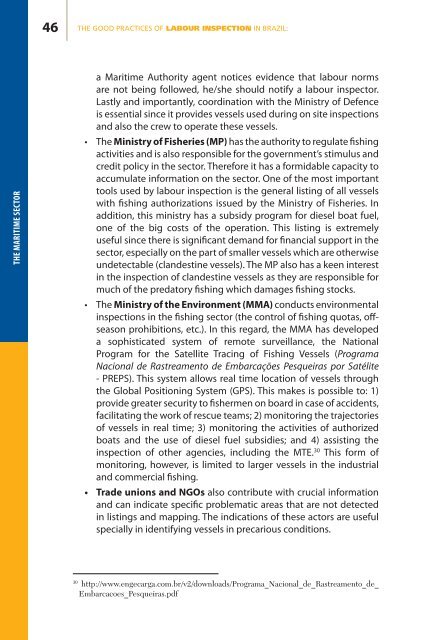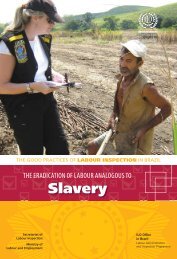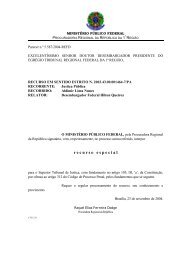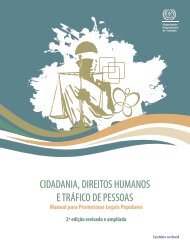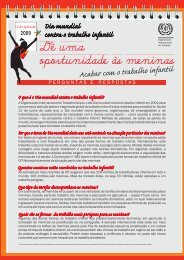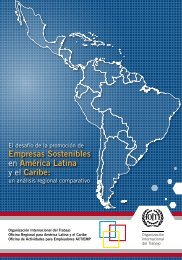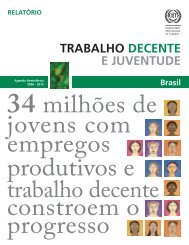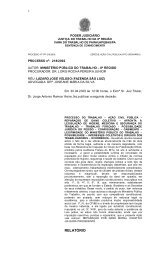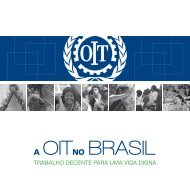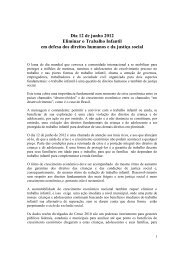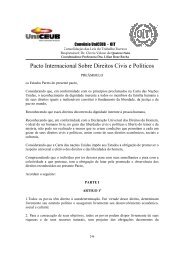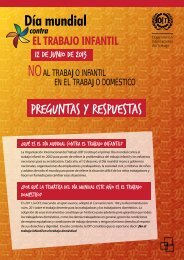The Maritime Sector
The Maritime Sector
The Maritime Sector
Create successful ePaper yourself
Turn your PDF publications into a flip-book with our unique Google optimized e-Paper software.
46THE GOOD PRACTICES OF LABOUR INSPECTION IN BRAZIL:THE MARITIME SECTORa <strong>Maritime</strong> Authority agent notices evidence that labour normsare not being followed, he/she should notify a labour inspector.Lastly and importantly, coordination with the Ministry of Defenceis essential since it provides vessels used during on site inspectionsand also the crew to operate these vessels.• <strong>The</strong> Ministry of Fisheries (MP) has the authority to regulate fishingactivities and is also responsible for the government’s stimulus andcredit policy in the sector. <strong>The</strong>refore it has a formidable capacity toaccumulate information on the sector. One of the most importanttools used by labour inspection is the general listing of all vesselswith fishing authorizations issued by the Ministry of Fisheries. Inaddition, this ministry has a subsidy program for diesel boat fuel,one of the big costs of the operation. This listing is extremelyuseful since there is significant demand for financial support in thesector, especially on the part of smaller vessels which are otherwiseundetectable (clandestine vessels). <strong>The</strong> MP also has a keen interestin the inspection of clandestine vessels as they are responsible formuch of the predatory fishing which damages fishing stocks.• <strong>The</strong> Ministry of the Environment (MMA) conducts environmentalinspections in the fishing sector (the control of fishing quotas, offseasonprohibitions, etc.). In this regard, the MMA has developeda sophisticated system of remote surveillance, the NationalProgram for the Satellite Tracing of Fishing Vessels (ProgramaNacional de Rastreamento de Embarcações Pesqueiras por Satélite- PREPS). This system allows real time location of vessels throughthe Global Positioning System (GPS). This makes is possible to: 1)provide greater security to fishermen on board in case of accidents,facilitating the work of rescue teams; 2) monitoring the trajectoriesof vessels in real time; 3) monitoring the activities of authorizedboats and the use of diesel fuel subsidies; and 4) assisting theinspection of other agencies, including the MTE. 30 This form ofmonitoring, however, is limited to larger vessels in the industrialand commercial fishing.• Trade unions and NGOs also contribute with crucial informationand can indicate specific problematic areas that are not detectedin listings and mapping. <strong>The</strong> indications of these actors are usefulspecially in identifying vessels in precarious conditions.30http://www.engecarga.com.br/v2/downloads/Programa_Nacional_de_Rastreamento_de_Embarcacoes_Pesqueiras.pdf


